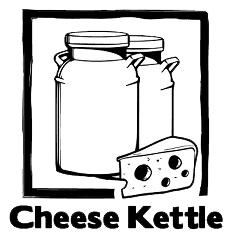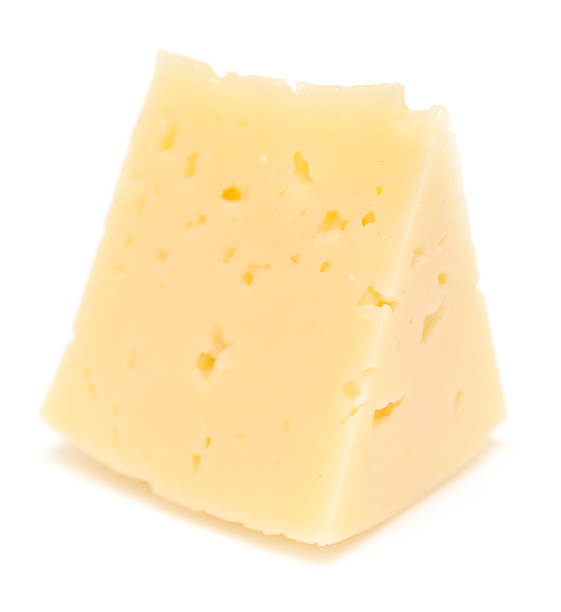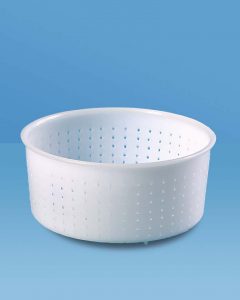Derby cheese is a mild, semi-firm cheese made from cow’s milk. A popular British cheese, Derby has a smooth, mellow texture and a buttery flavor. It has a pale, golden yellow interior. Derby is somewhat similar to cheddar, save for its softer body and slightly higher moisture content.
Yield: approximately 1 kg Derby cheese
Aging Time: less than 6 months
Ingredients
1. 10 L whole milk (don’t use ultra pasteurized milk)
2. 1/8 teaspoon Bioprox M265 Mesophilic Culture
3. ½ teaspoon Calcium Chloride (dissolved in ¼ cup non chlorinated water)
4. ½ teaspoon liquid rennet (diluted in ¼ cup non chlorinated water)
5. 2 ½ teaspoon cheese salt
Equipment
- Large stainless pot
- Thermometer
- Spoon or ladle
- Knife and curd cutter
- Colander
- Cheese cloth or butter muslin
- Cheese hoops
- Draining mat
- Cheese press
Recommended Cheese Hoops for Derby Cheese
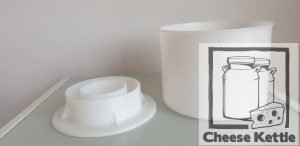
200 x 150 mm Round Hoop with fallower
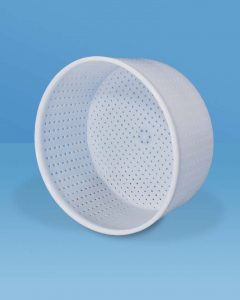
Instructions
Reminder: Sterilize all your equipment before making cheese.
1. Heat the milk to 290 C.
2. Sprinkle the mesophilic culture on the surface of the milk. Allow the culture to rehydrate for 5 minutes. Make sure you maintain the target temperature while the culture ripens.
3. Stir slowly for 1 minute in an up and down motion to mix the culture with the milk.
4. Cover the pot and allow the milk to ripen for 45 minutes. Keep the temperature steady.
5. Add the Calcium Chloride. Stir gently.
6. Add the rennet. Continue to stir in an up and down motion for another minute.
7. Cover the pot and allow the milk to set for 60 minutes or until you get a clean break. You can check for a clean break by poking the curd with a knife. If you can move it without the whey filling the space immediately, that is a clean break.
8. Cut the curds into ½-inch cubes.
9. Cover the pot and let the curds set for 5 minutes to allow it to heal.
10. Slowly heat the curds to 340 C in a span of 50 minutes. To do this, gradually increase the temperature by only 0.50 C every 10 minutes. Periodically stir the curds to prevent it from sticking together.
11. Once you’ve reached the target temperature, keep it steady and stir the curds continuously for 10 minutes.
12. Remove from the heat. Let the curds set for 10 minutes. The curds will be matted at this point.
13. Line the colander with cheesecloth or butter muslin. Scoop out the curd mass and put it in the colander.
14. Let it drain for 2 minutes.
15. Bundle the curds up in a bag and place it back in the pot and press it firmly with your hand.
16. Heat the curd mass back to 340 C for 15 minutes. You will notice that the whey will seep off again.
17. Put the bag of curds back in the colander to drain. Press with your hand to squeeze off the excess whey.
18. Turn the slab around, drain and allow to rest for another 15 minutes. Do this process (turn, drain and rest) four times.
19. Open the cheesecloth and put it on a chopping board. At this point, you already have a firm curd slab. Cut it into 1 ½ inch blocks.
20. Put the curds back to the pot. Mill the curds with your fingers into quarter size pieces. Make sure you don’t squeeze them too much.
21. Add the cheese salt. Mix it well using your hands.
22. Line the hoop with cheesecloth and put the curds in.
23. Press the cheese at 11 kg for 30 minutes.
25. Turn the cheese over and press at 22 kg for 3 hours.
26. Turn the cheese again and press still at 22 kg for 12 hours.
27. Air dry the cheese for 2 to 3 days, turning it twice daily.
28. Wax or vacuum seal the cheese. Mature for 1 to 3 months, turning it once weekly at a temperature of 130 C.
Sage Derby
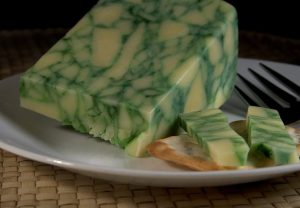
A variation of Derby cheese is Sage Derby. Adding sage to derby cheese gives it green marble streaks and an added flavor! Here’s how you can create this variation for your Derby cheese.
1. Finely chop some fresh sage leaves.
2. Place it in a container and add 2 cups of boiling water. Stir well. Allow it to seep until it gets cold.
3. Add the sage solution to the curds before salting it. Pour the sage water into the curds and mix it thoroughly.
4. Let the curds soak in sage water for 15 minutes.
5. After 15 minutes, transfer the curds into the cheese cloth lined colander to drain.
6. Mill the curds and follow the pressing and aging procedures mentioned above.
Port Wine Derby Cheese
If you want to have Derby cheese with a deep ruby red marbled effect, you can try creating another derby cheese variation- one infused with port wine! Instead of soaking the curds in sage water, you soak it in port wine instead.
1. After cutting the curds into 1 ½ inch blocks, put it back in the pot. Pour the wine into the curds. Put just enough wine to keep the curds covered to allow infusion.
2. Let the curds soak in the wine for an hour. The longer you soak the curds in the wine, the more color and flavor the finished cheese gets.
3. Once the curds have been well soaked, drain off the excess wine and salt the cheese.
4. Follow the pressing and aging procedures mentioned above.
Try These Other Cheese Recipes, Too!
Soft Cheeses
Hard Cheeses
Cheese Kettle supplies cheese making equipment and ingredients, from starter cultures, cheese hoops and cheese paper to machineries like pasteurizers and cheese vats and butter churners. We can even customize our equipment based on your dairy processing needs. Talk to one of our experts. Contact us today!
